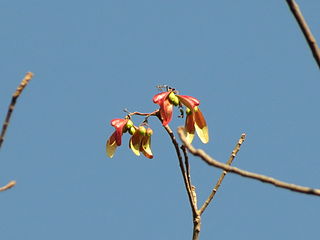
Bombax is a genus of mainly tropical trees in the mallow family. They are native to western Africa, the Indian subcontinent, Southeast Asia, and the subtropical regions of East Asia and northern Australia. It is distinguished from the genus Ceiba, which has whiter flowers.
Quercus mespilifolia is the accepted name of a tree species in the Asian sub-genus of 'ring-cupped oaks' and the family Fagaceae; there are no known subspecies.

Pterospermum grewiifolium is a tree species, now placed in the family Malvaceae: in the subfamily Dombeyoideae and described by Pierre. in the genus Pterospermum. No subspecies are listed in the Catalogue of Life and name is unresolved. In Viet Nam the species name is often listed as "P. grewiaefolium" and the vernacular name is lòng mang nhỏ, lòng mang lá cò ke.

Pterocymbium is a genus in the family Malvaceae: in the subfamily Sterculioideae and previously placed in the Sterculiaceae. In Indonesia, P. tinctorium (Kelumbuk) is a significant timber tree.
Metadina trichotoma is the sole species in the monotypic genus Metadina in the family Rubiaceae. It was first described by Heinrich Zollinger and Alexandre Moritzi, with its current name by Reinier Cornelis Bakhuizen van den Brink; no subspecies are listed in the Catalogue of Life.

Colona evecta is a tree species, first described by Pierre, in the genus Colona and now placed in the subfamily Grewioideae. No subspecies are listed in the Catalogue of Life.
Garcinia celebica is an accepted name of a tree species in the family Clusiaceae. The Catalogue of Life lists no subspecies.
Garcinia nigrolineata has been called "wild beaked Kandis" and is a tree species in the family Clusiaceae. The Catalogue of Life lists no subspecies.
Quercus petelotii is the accepted name of an endemic oak tree species in the Asian sub-genus of 'ring-cupped oaks' and the family Fagaceae; there are no known sub-species.
Quercus rupestris is the accepted name of an endemic small tree species in the Asian sub-genus of 'ring-cupped oaks' and the family Fagaceae.
Quercus setulosa is the accepted name of a tree species in the Asian sub-genus of 'ring-cupped oaks' and the family Fagaceae.
Quercus quangtriensis is the accepted name of a tree species in the Asian sub-genus of 'ring-cupped oaks' and the family Fagaceae; there are no known subspecies.

Quercus oblongata is the accepted name of a tree species in the Asian sub-genus of 'ring-cupped oaks' and the family Fagaceae; there are no known subspecies.
Quercus macrocalyx is the accepted name of a tree species in the Asian sub-genus of 'ring-cupped oaks' and the family Fagaceae; there are no known subspecies.
Quercus chrysocalyx is the accepted name of a tree species in the Asian sub-genus of 'ring-cupped oaks' and the family Fagaceae; there are no known subspecies. It is native to Cambodia, China (Yunnan), Laos, Thailand, and Vietnam.

Dipterocarpus baudii is the accepted name of a tropical forest tree species in the family Dipterocarpaceae; there are no known subspecies.
Ficus costata is an Asian species of fig tree in the family Moraceae. No subspecies are listed in the Catalogue of Life its native range is SW. India, Sri Lanka, Indo-China. The species can be found in Vietnam: where it may be called sung sóng.

Ficus kurzii may be called the Burmese banyan: it is an Asian species of fig tree in the family Moraceae. No subspecies are listed in the Catalogue of Life; its native range is China (Yunnan) Indo-China and Malesia. The species can be found in Vietnam: where it may be called Ða Kurz.
Ficus sumatrana is an Asian species of fig tree in the family Moraceae. No subspecies are listed in the Catalogue of Life; its native range is Indo-China to Malesia.

Ficus fistulosa is an Asian species of fig tree in the family Moraceae. No subspecies are listed in the Catalogue of Life; its native range is Assam to Taiwan, Indo-China, Malesia and New Guinea. The species can be found in Vietnam: where it may be called sung giòn.











